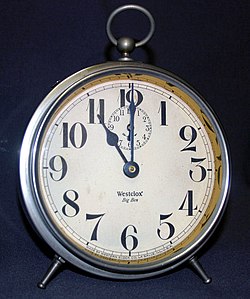12-hour clock

The 12-hour clock is a way of dividing the 24 hours of the day into two sections. The two halves are called ante meridiem (a.m.) and post meridiem (p.m.). Both names are from Latin and Latin: [ante meridiem] Error: {{Lang}}: text has italic markup (help), means "before midday" and Latin: [post meridiem] Error: {{Lang}}: text has italic markup (help) means "after midday".[1]
Each period has 12 hours and are numbered 12 (acting as 0), 1, 2, 3, 4, 5, 6, 7, 8, 9, 10 and 11. Time from midnight to one minute before noon is a.m. and from noon to one minute before midnight is p.m.. The table at right shows how it relates to the 24-hour clock.

The 12-hour time is common in several English-speaking countries and former British colonies (such as the United Kingdom, the United States, the English speaking parts of Canada or India), as well as a few other countries. There is no widely accepted convention for how midday and midnight should be represented: in English-speaking countries, "12 p.m." means 12 o'clock noon, while "12 a.m." means 12 o'clock midnight.[2][3][4]
| 24-hour clock | 12-hour clock | Period |
|---|---|---|
| 00:00 | 12:00 AM midnight (start of day) |
Postmidnight[5][6] |
| 01:00 | 1:00 AM | |
| 02:00 | 2:00 AM | |
| 03:00 | 3:00 AM | |
| 04:00 | 4:00 AM | |
| 05:00 | 5:00 AM | |
| 06:00 | 6:00 AM | Morning |
| 07:00 | 7:00 AM | |
| 08:00 | 8:00 AM | |
| 09:00 | 9:00 AM | |
| 10:00 | 10:00 AM | |
| 11:00 | 11:00 AM | |
| 12:00 | 12:00 PM noon midday |
Afternoon |
| 13:00 | 1:00 PM | |
| 14:00 | 2:00 PM | |
| 15:00 | 3:00 PM | |
| 16:00 | 4:00 PM | |
| 17:00 | 5:00 PM | |
| 18:00 | 6:00 PM | Evening |
| 19:00 | 7:00 PM | |
| 20:00 | 8:00 PM | |
| 21:00 | 9:00 PM | |
| 22:00 | 10:00 PM | |
| 23:00 | 11:00 PM | |
| 24:00 | 12:00 AM midnight (end of day) |
Postmidnight |
12-hour Clock Media
Exeter Cathedral Astronomical Clock, showing the double-XII numbering scheme.
World War II RAF sector clock that can be read either in 12- or 24-hour notation.
Typical digital 12-hour alarm clock indicating p.m. with a dot to the left of the hour.
References
- ↑ "Time". The New Encyclopædia Britannica. Vol. 28. 1986. pp. 660 2a.
"Time". Encyclopædia Britannica. Encyclopædia Britannica Online Library Edition. Retrieved 20 November 2013.The use of AM or PM to designate either noon or midnight can cause ambiguity.
- ↑ "Is noon 12 am or 12 pm?". Royal Museums Greenwich. Retrieved 2023-01-26.
- ↑ "U.S. Government Printing Office Style Manual - Chapter 12 - Numerals". govinfo.gov. Retrieved 2023-01-27.
- ↑ "time of day, elapsed time". Resources of the Language Portal of Canada. 2020-10-22. Retrieved 2023-01-27.
- ↑ https://www.yourdictionary.com/postmidnight
- ↑ https://dictionary.reverso.net/english-definition/postmidnight


